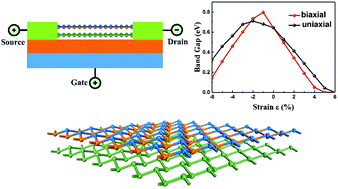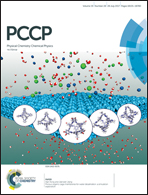A two-dimensional van der Waals CdS/germanene heterojunction with promising electronic and optoelectronic properties: DFT + NEGF investigations†
Abstract
Two new 2D materials, germanene and monolayer cadmium sulfide (CdS), have been theoretically predicted and experimentally fabricated recently. In this work, we conduct a systematic investigation of the geometry structure, electronic, optical, and transport properties of a CdS/germanene heterojunction by using density functional theory (DFT) combined with the nonequilibrium Green's function (NEGF) formalism. Despite the gapless nature of germanene, the CdS/germanene heterojunction is found to be a direct band gap semiconductor, with a band gap of 0.644 eV. In particular, applying external strain can effectively tune the electronic band structure and optical properties of the CdS/germanene bilayer in a wide range, and a semiconductor–metal transition can even be achieved. In addition, the transport property calculations show that the current–voltage (I–V) relation of the CdS/germanene bilayer exhibits sensitive responses to the applied strain with a marked change in the I–V relation. Such superior electronic, optical, and transport properties make the CdS/germanene heterobilayer a promising candidate for electronic and optical device applications.



 Please wait while we load your content...
Please wait while we load your content...